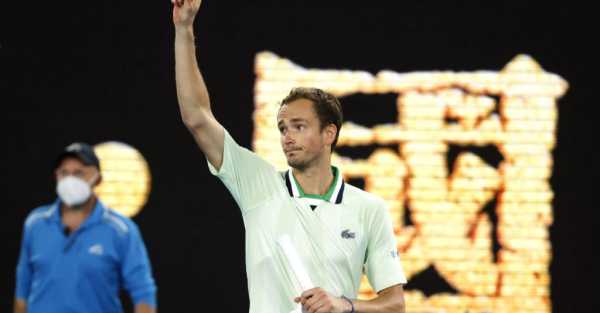
Daniil Medvedev branded the Australian Open crowd “low IQ” after surviving a second-round clash with Nick Kyrgios.
The meeting between the Australian showman and the world number two and title favourite was the biggest match of the tournament so far and it lived up to its billing on a raucous Rod Laver Arena.
The noise heightened when Kyrgios won the third set but Medvedev, who has had his fair share of mad moments, kept his cool in a 7-6 (1) 6-4 4-6 6-2 triumph.
The Russian was especially unhappy with fans making noise between his first and second serves, with Cristiano Ronaldo’s ‘siuu’ chant again making its presence felt at Melbourne Park.
Advertisement
Speaking to Eurosport, Medvedev said: “It’s not everybody who’s doing it, but those who are doing it probably have a low IQ.”
In his press conference later, the second seed said: “I enjoyed to win. It’s not easy to play against the crowd. I feel like these matches, they are not easy to play, but they stay as fun matches afterwards, because in the end we gave the crowd a big show. Probably Nick more because he’s a big entertainer.”
Kyrgios agreed with Medvedev about the noise between serves, but said: “I thought the atmosphere was awesome. That’s what sport is.
“You’ve got the most entertaining player playing in his home slam on Rod Laver. You’d expect the crowd to be like that. I can understand it’s a gentleman’s game but it’s about time that people embraced some sort of different energy in this sport otherwise it will die out. It’s just that simple.”
Medvedev, who next faces Dutchman Botic van de Zandschulp, hopes coming through Thursday’s match will stand him in good stead for the rest of the tournament.
“I can say it’s definitely an unlucky draw,” he said. “But these kind of matches, first, second, third round of a slam, it’s like a big challenge where, if you make it, you feel like, ‘OK, if I can continue playing like this, I can go far’.”
Advertisement
Kyrgios had not played a match since September going into the tournament and was in bed with Covid last week but showed once again what a phenomenal talent he is.
He said: “I’m incredibly proud of my performance today. I think if you asked everyone on tour, I think they would probably vote him the best player in the world at the moment. I threw everything I could at him.
“From where I was with my struggles the last four, five months, to be feeling like this and, obviously I had Covid a couple of days before, I’m just proud of the way I responded. If I play 95 per cent of people tonight on that court, I think I win.”
Regarding speculation that this could be his final year in the game, Kyrgios said: “I don’t know what I’m going to be doing in a year’s time. I’m probably playing tennis, but I don’t know.”
Fourth seed Stefanos Tsitsipas did not have things all his own way either against Sebastian Baez but finished strongly to win 7-6 (1) 6-7 (5) 6-3 6-4. He will next take on France’s Benoit Paire, who knocked out Grigor Dimitrov.
Advertisement
Fifth seed Andrey Rublev eased into round three and will face Marin Cilic while ninth seed Felix Auger-Aliassime needed four hours and 19 minutes to see off Alejandro Davidovich Fokina in four sets.
Sourse: breakingnews.ie